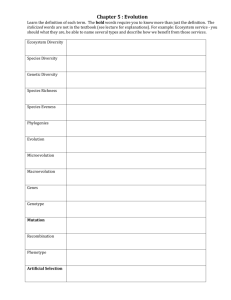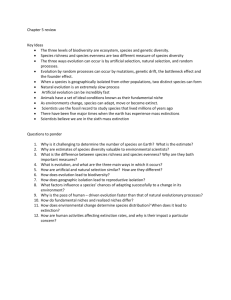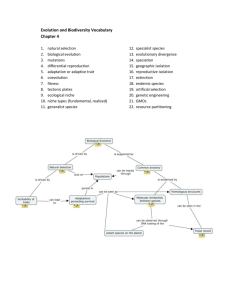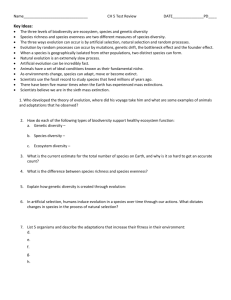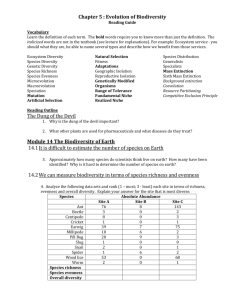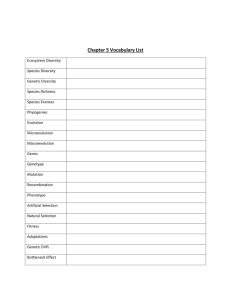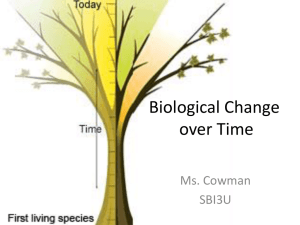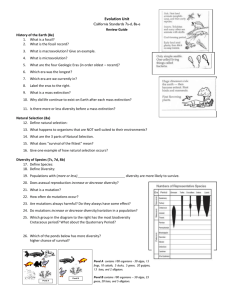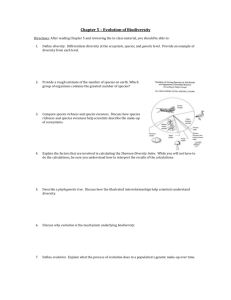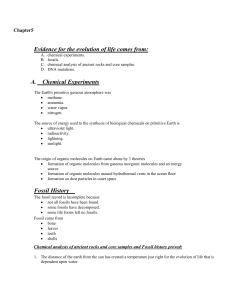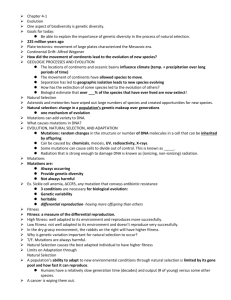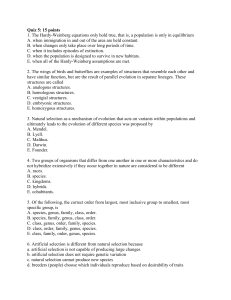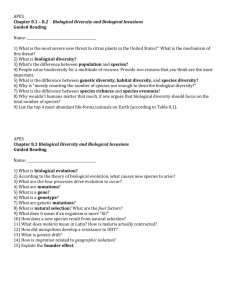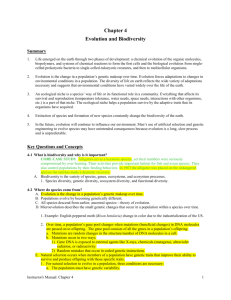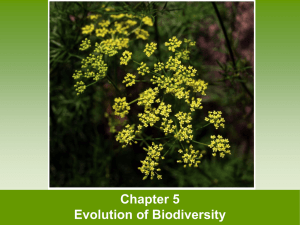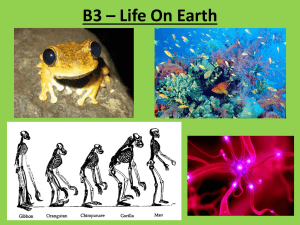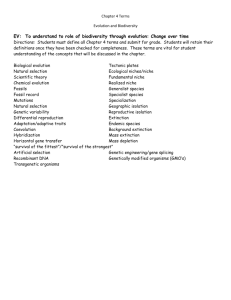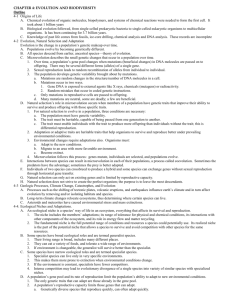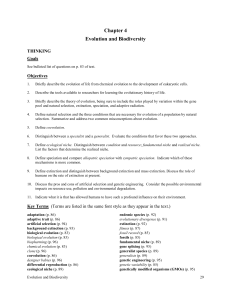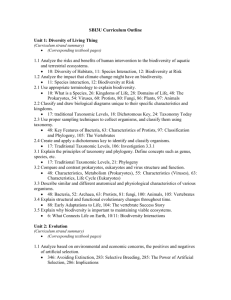Chapter 5 Objective Questions Evolution of Biodiversity The Dung of
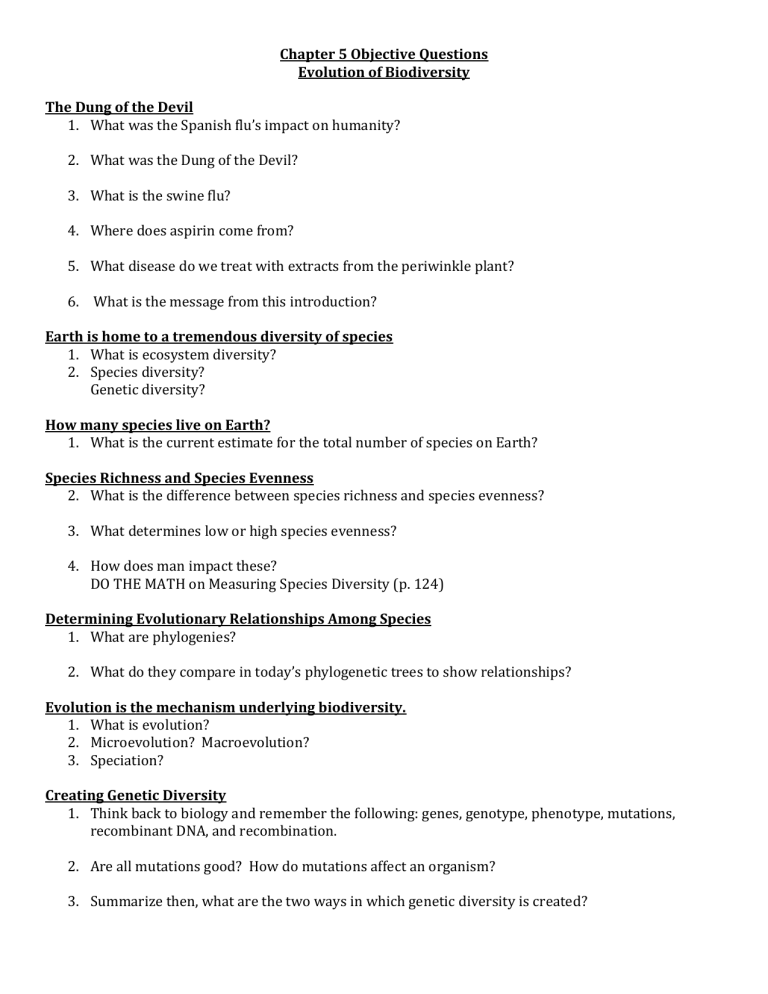
Chapter 5 Objective Questions
Evolution of Biodiversity
The Dung of the Devil
1.
What was the Spanish flu’s impact on humanity?
2.
What was the Dung of the Devil?
3.
What is the swine flu?
4.
Where does aspirin come from?
5.
What disease do we treat with extracts from the periwinkle plant?
6.
What is the message from this introduction?
Earth is home to a tremendous diversity of species
1.
What is ecosystem diversity?
2.
Species diversity?
Genetic diversity?
How many species live on Earth?
1.
What is the current estimate for the total number of species on Earth?
Species Richness and Species Evenness
2.
What is the difference between species richness and species evenness?
3.
What determines low or high species evenness?
4.
How does man impact these?
DO THE MATH on Measuring Species Diversity (p. 124)
Determining Evolutionary Relationships Among Species
1.
What are phylogenies?
2.
What do they compare in today’s phylogenetic trees to show relationships?
Evolution is the mechanism underlying biodiversity.
1.
What is evolution?
2.
Microevolution? Macroevolution?
3.
Speciation?
Creating Genetic Diversity
1.
Think back to biology and remember the following: genes, genotype, phenotype, mutations, recombinant DNA, and recombination.
2.
Are all mutations good? How do mutations affect an organism?
3.
Summarize then, what are the two ways in which genetic diversity is created?
Genotypes Versus Phenotypes
1.
What is the difference between these two terms?
Evolution by Artificial Selection
1.
What is the difference between natural selection and artificial selection?
2.
What are ways in which man artificially selects?
3.
What are examples of unintended results in artificial selection?
Evolution by Natural Selection
1.
What did Charles Darwin and Alfred Wallace contribute to the ideas of the time?
2.
You learned all about this in biology so review the trip Darwin made on the HMS Beagle and where he traveled. What did he do along the way?
3.
What are the key ideas to Darwin’s theory of evolution
4.
What is the difference between fitness and adaptation?
5.
What are some ways we can ‘improve’ species and for what reasons would we do this?
Evolution by Random Processes
1.
What are the four random processes?
Mutations
1.
How do mutations contribute to evolution?
2.
Example?
Genetic Drift
1.
What is genetic drift?
2.
Example?
Bottleneck Effect
1.
What is the bottleneck effect?
2.
Example?
Founder Effect
1.
What is the founder effect?
2.
Example?
Use Figure 5.12 to help you differentiate between these different random processes.
Speciation and extinction determine biodiversity.
Allopatric versus Sympatric Speciation
1.
What is geographical isolation?
Example?
2. What is reproductive isolation?
Example?
3.What is allopatric isolation?
Example?
4.What is sympatric isolation?
Example?
5.What is polyploidy? Think back to your genetics – haploid and diploid.
6.How does it lead to a new species?
The Pace of Evolution
1.
What is the average global rate of evolution?
2.
What determines how quickly a population evolves?
3.
What four factors influence successful adaptation?
Rate of Environmental Change
1.
How can changes in the pH of an environment, if it is rapid, impact a population in comparison to when there is a slow change?
Genetic Variation
1.
How does genetic variation lend itself to the adaptation process?
Make sure you understand Figure 5.17.
Population Size
1.
How do mutations that are beneficial differ in their increase based on population size?
2.
Which is more likely to undergo rapid evolution by random processes – small or large?
Generation Time
1.
How does maturity rate affect evolution?
2.
How does artificial selection impact evolution?
3.
What have they done to cod populations?
4.
What are genetically modified organisms?
5.
What does the process of genetic engineering do?
6.
What is Bacillus thuringiensis and what have they used this for in corn?
Evolution shapes ecological niches and determines species distribution.
1.
What is range tolerance?
2.
What is the fundamental niche?
3.
What are some abiotic and biotic limitations to an organism’s niche?
4.
What is a realized niche
5.
What are niche generalists? Niche specialists?
Make sure you understand Figure 5.18.
Environmental Changes and Species Distribution
1.
What is the average life span of a species?
2.
What are reasons a species might go extinct?
The Fossil Record
1.
How are fossils formed?
2.
In what type of rock will fossils form?
The Five Global Mass Extinctions
1.
When was the greatest mass extinction? What happened at this time?
2.
When was the Cretaceous period extinction? What is the debate about in regards to this extinction?
The Sixth Mass Extinction
1.
What percentage of species is estimated to disappear by the year 2020?
2.
To what do scientist attribute this?
3.
What is the recovery time expected if this should occur?
Working Towards Sustainability - Buying the Oceans?
1.
What is the TNC?
2.
What is it trying to accomplish in coastal ecosystems?
3.
How is it hoping to accomplish this?
Work the FRQ and the Measuring Your Impact to practice your math essay writing skills. The multiple-choice questions are great examples of what you will see on the APES exam.
Read Science Applied – How Should We Prioritize the Protection of Species Diversity?
1.
What are endemic species?
2.
What are biodiversity hotspots? Be familiar with many of the locations of these hotspots.
